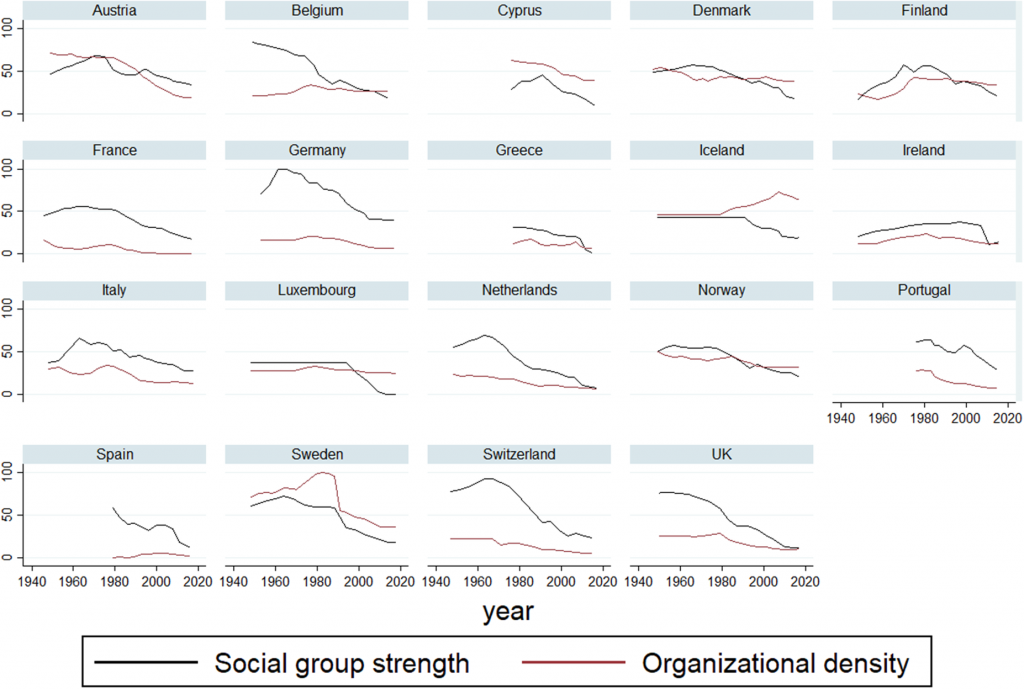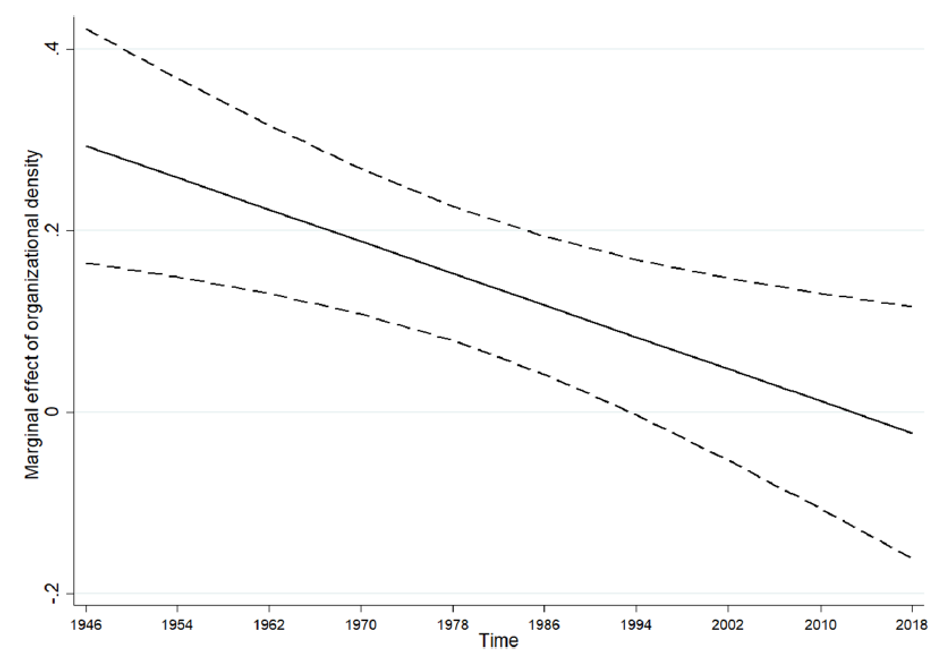*This post has been originally published on the LSE EUROPP Blog
The electoral strength of left-wing parties has traditionally been linked to the size and nature of a country’s working class and the existence of strong organisations such as trade unions. But are these ‘class cleavage’ factors still important in today’s politics? Drawing on a new study, Vincenzo Emanuele finds that while the characteristics of the working class are still a significant predictor of votes for the left, the importance of the organisational dimension has largely disappeared over the last two decades.
Conventional wisdom in today’s Western European politics is that left parties, and especially social democratic parties, have been experiencing an unrestrainable electoral decline. Journalists and pundits have highlighted the recent dramatic collapse of social democratic parties in several countries. In France, the Socialist Party fell from 29.4% to 7.4% in the 2017 legislative elections. In Germany, the support for the Social Democratic Party halved over the course of two decades, from 40.9% in 1998 to 20.5% in 2017, and the party is expected to be replaced by the Greens as the main political force of the centre-left camp in the next elections to be held in September.
The Italian centre-left coalition reached a new record-low result in the 2018 parliamentary elections (23.3%). Similar record-low results for social democratic parties occurred in Sweden in 2018 (28.3%), in Switzerland in 2019 (16.8), and especially in the Netherlands, where the Labour party collapsed to 5.7% in the last two parliamentary elections (2017 and 2021). Although in some countries the social democratic fall has been counterbalanced by the rise of radical left parties, like in Greece and Spain, the general picture of the European left is indisputably a gloomy one.
Based on such evidence, comparative politics scholars have investigated the factors explaining the fall of the Western European left, ranging from transformations in social structures (the working-class shrinking) to behavioural changes (voters are mobilised according to post-materialist issues cutting across traditional class loyalties). Other scholars have pointed to the ideological moderation of parties on the left and their convergence with the mainstream right through a decreased emphasis on traditional economic left goals. This is claimed to have alienated the support of the traditional working-class base.
However, a smoking gun has yet to be found. According to the classical cleavage theory by Seymour Martin Lipset and Stein Rokkan, the left’s electoral mobilisation is a function of class cleavage strength. The latter can be empirically measured by looking at two main elements: social group strength and organisational density. The former refers to the characteristics of its core social constituency, namely the working class. The more sizeable and industry-based the working-class is, the larger the expected support for the left. The latter instead refers to the corporate and partisan components of the cleavage, namely trade unions and left party organisations. The denser the organisational encapsulation within trade unions and left parties, the larger the electoral support for the left.
Class cleavage roots and electoral mobilisation
Starting from these premises, in a new study, I investigate whether left parties are still linked to their historical class cleavage roots or, instead, whether the electoral support for the former is completely detached from the socio-structural and organisational features from which such parties originally stemmed.
The link between class cleavage roots and left electoral mobilisation is tested through a comparative longitudinal research design that takes into account 19 Western European countries and their parliamentary elections in the whole post-World War II period (345 elections) so as to offer a comprehensive perspective that goes beyond the mere assessment of the last few years and allows for an accurate analysis of long-term changes.
The analysis shows that support for left parties – communist, socialist, social-democratic, and labour parties – has remained quite stable from 1946 to 2010, with an average of 38% and a peak of 40.4% in the 1970s. Notably, the last decade is characterised by a remarkable decline: the aggregate vote share of left parties decreases to an average of 31.9% in the 2010s, and this decline is even more pronounced if one excludes Southern European countries (27.6%).
Moreover, contrary to many claims about the recent alleged right-wing shift of left parties, an empirical test based on Comparative Manifesto Project data from 1945 and 2018 unequivocally rejects the hypothesis that left parties have shifted ideologically away from traditional economic left goals. Conversely, the analysis shows that left parties can still be safely considered as the legitimate representatives of the working-class side of the class cleavage.
Figure 1: Social group strength and organisational density
Note: The figures are country averages. For more information, see the author’s accompanying study.
Moving to focal predictors, Figure 1 shows that the class cleavage may assume different configurations in Western European countries. Not surprisingly, Scandinavian countries like Sweden and Denmark, as well as Austria, show the strongest class cleavage, while Greece and Ireland fall at the bottom of the ranking. However, the two aspects may not converge, and the development of dense organisational networks (strong trade unions and left parties) is not necessarily linked to the presence of a sizeable and industry-based working class.
This is the case of Cyprus and Iceland, which display relatively strong organisations in the context of a small and heterogeneous working class, but also of Germany and Switzerland, where the opposite situation of a strong social group goes hand in hand with a comparatively weak organisational density. At any rate, by looking at the evolution over time of class cleavage roots reported in Figure 2, a general picture of decline emerges: the working class has shrunk in size and has become less industry-based, while trade unions and left parties have lost members. This picture is fairly consistent across countries.
Figure 2: Temporal evolution of social group strength and organisational density (1946–2018)
Note: For more information, see the author’s accompanying study.
However, this trend does not necessarily mean that, despite its reduced weight in Western European politics, the class cleavage no longer translates into left electoral support, as was the case at the time of the origin of class electoral mobilisation. The empirical test of the association between class cleavage roots and left electoral mobilisation – controlling for other social, institutional, and political factors that may affect this relationship – shows that the class cleavage has a significant impact on the electoral support for left parties in Western Europe in the period between 1946 and 2018.
All else being equal, both a sizeable and industry-based working class and a dense organisational network increase the electoral support for left parties. What notably differentiates the two elements of the class cleavage is the evolution over time of their impact on left electoral support. Indeed, while social group strength has remained a substantial predictor of left electoral mobilisation even in recent decades, the impact of organisational density – as Figure 3 shows – has dramatically decreased over time and has become no longer significant in the last twenty-five years.
Figure 3: Impact of organisational density on left parties’ electoral support over time
Note: For more information, see the author’s accompanying study.
In a nutshell, the analysis tells us that the class cleavage is not entirely ‘lost in translation’, as a sizeable and industry-based working class is still today an important predictor of left electoral mobilisation. Nevertheless, such mobilisation is no longer mediated by the corporate and partisan organisations, the original vectors of cleavage translation. Indeed, membership in trade unions and left-wing parties are no longer associated with left electoral support.
These results deserve careful future consideration and have important implications for the study of cleavages and elections. In particular, they raise fundamental questions about the future of left parties and their class cleavage roots. Will the persistent link between the class cleavage’s socio-structural roots and left electoral mobilisation be a sufficient factor for class bloc parties’ electoral resilience, despite the missing link with class cleavage’s organisational roots? Or, instead, will the breakage of the transmission belt between organisational density and left electoral mobilisation cause an electoral disintegration of these parties in the near future? Further research should carefully address these questions, whose answer is paramount for our understanding of class politics and electoral competition in twenty-first-century Europe.
For more information, see the author’s accompanying paper in Perspectives on Politics



